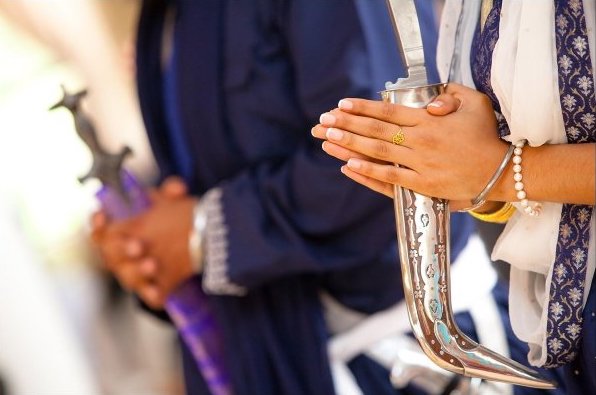This article is part of Kaur Life’s Black Lives Matter series created by Kaur Life board members and project advisors. Be sure to check out all of the articles.
Article 1: Should Sikhs Care About Black Lives Matter?
Article 2: Why Should Kaurs Support BLM?
Article 3: How Does anti-Blackness Show Up in the Sikh Community?
Article 4: How and Why do Sikhs Align with Whiteness?
Article 5: How Sikhs Can Become Anti-Racist and Support Black Lives Matter
Since the police murder of George Floyd, our social media feeds become overrun with images of protestors at Black Lives Matter (BLM) rallies, demonstrations, and marches, many of us are moved. Many of us want to join them in solidarity. At Kaur Life, we feel ignited and inspired to take action.
The connection between supporting BLM and a Sikh’s social justice duty may be obvious to some. It is heartwarming to see Sikhs showing up to march and demonstrate for BLM and against police violence, across the world. When we recognize the Divine in all, we see the need to stand up for the rights of all. When we reflect on Sikh history and gurbani, we realized that our Gurus and ancestors fought for egalitarian societies.
We see Black people demanding civil rights and to be treated as human beings, similar to Sikhs demanding religious rights to practice Sikhi in India and America. We see the police using violence against Black bodies, similar to how the Indian police use violence against Sikhs. We see Black leaders invoke spiritual and historical literature, similar to how Sikh freedom fighters against British occupation referenced social justice documents.
For some, the connection may not clear. There may be some Sikhs who are challenged to see why we should get involved with BLM. At best, this is out of a lack of understanding. At worst, it is a desire to distance themselves from the cause.
Punjabi-Sikhs in America have generally been absent from historical civil rights movements. But we should not be silent or complacent on the topic of Black rights, police brutality, and white supremacy*.
We must care about BLM.
Here’s why.
Equal Rights is Central in Gurbani
For this article, we will be employing the Sikh Research Institute’s model of combining Gurbani, Sikh history (tvarik), and Sikh practice (rheat) to gain insight into how to tackle modern problems through a Sikh lens. We start with Gurbani.
In Gurbani, the Gurus declared everyone to be equal and, as such, they strove to create a just and compassionate society that allowed everyone to flourish and reach their full potential. There are countless Shabads revealed to the Gurus describing the One Divine Force within all of us.
Tradition says that Guru Nanak Sahib’s first words after his Divine revelation at the Kali Bein River was, “Ik Onkar”. Meaning, there is One origin of everything in the universe. The One is the source of everything. The Supreme Divine Force is within all of us.
“One of Guru Nanak’s fundamental messages is the oneness of all humanity,” writes Dr. Satpal Singh. “He spoke emphatically against the notion of inequality and the resulting mistreatment of one segment of society by another….Guru Nanak emphasized that all humans, being children of the same One Creator or One Divine, are divinely interconnected. The same Divine… permeates all of us, and we are all an integral part of the same Divine. As a natural consequence, no one is superior or inferior to anyone else, whether it is in the context of gender, religion, caste, or anything else.”
Similarly, the singular life force and energy that pervades all was revealed to Guru Arjan Sahib (Ang 617).
ਊਚ ਨੀਚ ਮਹਿ ਜੋਤਿ ਸਮਾਣੀ ਘਟਿ ਘਟਿ ਮਾਧਉ ਜੀਆ ॥੧॥
uooch neech meh jot samaanee ghaT ghaT maadhau jeeaa ||1||
The Divine Light is contained in high caste and low caste people – in the hearts of all beings. ||1||
ਸੰਤਹੁ ਘਟਿ ਘਟਿ ਰਹਿਆ ਸਮਾਹਿਓ ॥
sa(n)tahu ghaT ghaT rahiaa samaahio ||
O Saints, The Divine is pervading and permeating each and every heart.
The message of human equality continues with Bhagat Kabir Sahib (Ang 1349) who explained:
ਮਾਟੀ ਏਕ ਅਨੇਕ ਭਾਂਤਿ ਕਰਿ ਸਾਜੀ ਸਾਜਨਹਾਰੈ ॥
maaTee ek anek bhaa(n)t kar saajee saajanahaarai ||
The clay is the same, but the Fashioner has fashioned it in various ways.
ਨਾ ਕਛੁ ਪੋਚ ਮਾਟੀ ਕੇ ਭਾਂਡੇ ਨਾ ਕਛੁ ਪੋਚ ਕੁੰਭਾਰੈ ॥੨॥
naa kachh poch maaTee ke bhaa(n)dde naa kachh poch ku(n)bhaarai ||2||
There is nothing wrong with the pot of clay – there is nothing wrong with the Potter. ||2||
Equality and Social Justice in Sikh History
It is our duty to continue the efforts of the Sikhs who came before us. “The Sikh movement was continually engaged,” writes scholar Jagjit Singh. “First in propagating the ideas of complete human freedom and equality, then in building a society based on these ideas, and finally, in creating, through the Panth, a political revolution.”
The Sikhs in our history, including our Gurus, fought for human rights and equality. For instance, Guru Amar Das Sahib continued to abolish the caste system, which is deeply connected to colorism and anti-Blackness. When Guru Arjan Sahib compiled the Adi Granth, he included the scriptures of “low-caste pariah” Bhagats who were never permitted to enter various temples. Mata Khivi and Guru Angad Sahib institutionalized langar and served everyone, regardless of status, position, or caste, on the floor. Mata Khivi was known to serve everyone. Guru Tegh Bahdur Sahib stood up for the rights of Hindu Kashmiri Pandits which, ultimately, led to his execution (shaheedi). He was known as “Srishat di Chadar” or “Protector of Humanity” as per Sainapati in Sri Gur Sobha, the court-poet of Guru Gobind Singh. Our original Panj Piare were of five different castes and declaring, “Maanas ki jaat sabai ekai pehchaanbo,” or “Recognize all of humanity as one,” Guru Gobind Singh Sahib amalgamated them into one Khalsa. Bhai Kanhaiya Ji gave water to all wounded soldiers, to Sikhs and the opposing Mughal forces, in the 1704 Battle of Anandpur Sahib. Mata Bhag Kaur (aka Mai Bhago) fought against Aurangzeb’s reign of bigotry, religious intolerance, violence, and terror.
One of the most visual and striking examples of Sikh values at play was the creation of the Khalsa, a body created to be devoted to the service of humanity. “Guru Gobind Singh established the Khalsa with the deliberate plan that the downtrodden, including the outcasts, should capture political power,” writes Jagjit Singh. So why should our mission end in Punjab in 1699? Right now, the oppressed in America, are Black people, Indigenous people, people of color, religious minorities, LGBTQIA+ communities, and women. So, it is our duty, as charged by Guru Gobind Singh, to stand besides these groups in their fight for empowerment. The historical precedent has been set for Sikhs to serve people beyond our Panth, to fight for justice for those who do not look like us, and to uproot tyranny everywhere.
We Know What it Feels Like to be Persecuted
If the social justice charge set forth by our Gurus seems like a distant intangible, perhaps we can draw upon our empathy and compassion to understand the plight of the Black community in America. As Sikhs, we know firsthand what it feels like to be persecuted for the way we look and what we believe. For example, the Indian police has disappeared, tortured, and murdered Sikhs for decades. In the United States we are targets for hate crimes and discrimination. Simply because we know what it feels like to be “othered”, we should have empathy with the Black Lives Matter movement.
Recently, Amneet Singh Bali, the Deputy Director of Outreach with Jagmeet Singh and Canada’s NDP, wrote, “To all my Sikh friends and family we have a duty to pull up for our Black siblings. Here’s why.
June 1, 2020 will mark the 36th Anniversary of the Sikh Genocide – a period when Indian state authorities and police officers abducted, tortured, murdered, and secretly cremated thousands of young Sikhs. We grew up witnessing these atrocities with images of tortured bodies, who resembled us so strikingly, that it felt like we were looking into a mirror. We became surrogate victims and carriers of a deep-rooted pain that we carry with us today.⠀
Today, right before our very eyes, we see strikingly similar images of Black people who have faced centuries of sustained, prolonged, and systemic injustice being subjected to cruelty and genocidal acts of murder. So, as we observe the 1984 Sikh Genocide let’s do so with acts of solidarity that confront anti-Blackness. Let’s confront it by pulling up for our Black siblings and by confronting anti-Blackness in our own communities.”
(Edited for clarity and gendered language was replaced with gender neutral terms).
For the Black Sikhs in our Communities
Sikhi transcends race, caste, nationality, and other borders of difference. While most Sikhs are Punjabi, people from different backgrounds also follow the Gurus. While few and far between, there are several Sikhs who are Black. Most famously, yoga teacher Hari Krishina Kaur and blues musician Avtar Singh Khalsa, and their children Lakhmi Chand Singh and Siri Chand Singh.
Unfortunately, many Sikhs who are Black report facing compounded discrimination – from white society and South Asian Sikh spaces. Anti-Blackness in a religious community that claims to believe in equality is hypocritical and leads to dangerous exclusionary practices based in white supremacy. It is our duty to create safe-spaces where Sikhs who are Black are embraced as fully human and fully Sikh.
We are Indebted to Black Civil Rights Leaders
Beyond our spiritual duty to fight for justice for our Black siblings, we are also indebted to them. The many freedoms we have as Sikhs in America is because of the sacrifices made by Black civil rights leaders. “We all have a certain responsibility to those who have made it possible for us to take advantage of today’s opportunities,” said Angela Davis. The Sikh diasporic American community exists and thrives due to the work of Black activists fighting racial oppression.
Immigrating to America
“If you are Desi-American and your family immigrated here after 1965, you owe that to the Civil Rights Movement,” writes the South Asian Sexual & Mental Health Alliance (SASMHA) . Let’s explore that further…
In the early 1900s, there were several landmark state and national laws striving to preserve white homogeneity, like the “National Origins Formula”. During this time, the California Board of Control wrote “California and the Orientals” in which they claimed Sikhs (and other Asian groups) posed an economic threat to the state. In other words, white leaders in California wished to preserve their wealth, monopolize capital, and maintain economic power over immigrant communities, in part by exploiting their labor and preventing them from accumulating wealth. (Check out Cedric Robinson’s theory of racial capitalism to learn more). “These types of statements stirred up anti-Asian feelings among other groups of people, often with dire consequence,” writes Margaret Hill. Such reports and legislation barred or restricted non-white immigrants, from immigrating to America, obtaining citizenship, and owning land. It also did not protect non-white immigrants from wage discrimination, discrimination at funerals, and marriage discrimination.
Who helped reform these laws? In large part, Black civil rights leaders and activists.
“The Civil Rights Movement brought attention to racial oppression in the US, including to immigration policies,” writes SASMHA. “Racially-motivated [immigration] policies were still in effect well into the 1960s. The clearly discriminatory immigration policies were seen as an embarrassment in the international community. The immigration and nationality act of 1965 (aka the Hart-Celler Act) opened up immigration to all Asian countries. This law was not an explicit part of the Civil Rights legislative platform in the late 1960s – it was not actually meant to upend the ethnic composition of the US. But it was passed in the backdrop of other Civil Rights legislation due to the pressure from the movement to de-radicalize American policies. The majority of Desi-Americans in the US now are here due to the provisions of the Hart-Cellar Act. Getting rid of restrictive quotas and allowing family-based immigration has fundamentally changed the population of the US. The vast majority of Desi-Americans can trace their families’ immigration to consequences of this piece of legislation.”
Greater Economic Opportunities
In addition to paving the way for Sikh and South Asian immigrants, the Black community has worked to widen access for racial minorities, from education to employment.
It was Black Americans who mobilized during World War II to pressure President Franklin D. Roosevelt to establish the Fair Employment Practices Committee. “After the war, there was a nationwide push for fair employment practices legislation, which eventually paved the way for the rise of affirmative action in the 1960s,” says Ellen Wu, historian and the author.
“By the 1970s, the federal government widened the scope of affirmative action and related minority rights efforts to include Asian Americans, leading to greater employment opportunities for them across different sectors,” says Wu.
We Get to Practice Sikhi in America
Sikhs also benefit from the rights and securities established by The Civil Rights Act of 1964. This act was created by, pushed through, and fought for by Black activists. The Civil Rights Act of 1964 ended official segregation in public places and banned employment discrimination on the basis of race, color, religion, sex, or national origin. That’s why today, wearing a dastar or chunni is protected by law, and being a Sikh doesn’t bar you from employment.
What You Can Do
From Gurbani, to Sikh history; from empathy to indebtedness, Sikhs must stand up to say Black Lives Matter and to create a more just and compassionate society where all people can thrive and reach their full potential. It is our moral imperative to not be silent or complacent on the topic of Black rights, police brutality, and white supremacy.
To start or continue your journey to become anti-Racist, check out our list of resources, actions, advocacy, and self education you can engage in. We’ve also included a section on how you can challenge racism in your families, amongst friends, in sangat, and at Gurdwara.
*A note on white supremacy
From Harleen Kaur, Kaur Life Board member, PhD candidate in Sociology, studying white supremacy & institutional racism:
While our modern understanding of white supremacy is very much rooted in neo-nazi groups, like the KKK, white supremacy is as simple as the idea (explicit or unacknowledged belief) that white people are innately superior/deserving of better treatment/livelihood/etc.
White supremacy is “a political, economic, and cultural system in which whites overwhelmingly control power and material resources, conscious and unconscious ideas of white superiority and entitlement are widespread, and relations of white dominance and non-white subordination are daily reenacted across a broad array of institutions and social settings,” Ansley, Frances L. 1989. “Stirring the Ashes: Race, Class and the Future of Civil Rights Scholarship.” Cornell Law Review 74(6):993–1077.
Within that, we also have the counter force of anti-Blackness, or the idea that Black people (and other racialized people who are not white) do not deserve the same treatment, and in fact much worse.
This article is part of Kaur Life’s Black Lives Matter series created by Kaur Life board members (Lakhpreet Kaur, Isha Kaur, Harleen Kaur, Dr. Mohan Singh, & Sukhjinder Kaur) and project advisors (Jaipreet Kaur & Darsh Singh). Be sure to check out all of the articles.
Article 1: Should Sikhs Care About Black Lives Matter?
Article 2: Why Should Kaurs Support BLM?
Article 3: How Does anti-Blackness Show Up in the Sikh Community?
Article 4: How and Why do Sikhs Align with Whiteness?
Article 5: How Sikhs Can Become Anti-Racist and Support Black Lives Matter
Feature photo by Sehaj Kaur. All rights reserved. Photo cannot be used, replicated, modified, or distributed without the express consent of the photographer. Special thanks to Princepal Singh for sharing this photos of the Austin Justice Coalition’s Black Lives Rally and March which took place in Austin, TX on June 7, 2020. Pictured (L to R) is Princepal Singh, Isha Kaur and Harjot Kaur.





No Comments